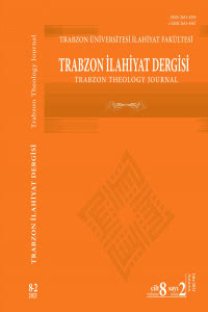Kur’an’ın Tefsir ve Tercümesinde Bağlamın Rolü
Kur’ân’ın anlaşılması, yorumlanması ve başka bir dile çevrilmesi hususunda bağlam çok önemli bir rol oynamaktadır. Fakat Kur’ân’ın İngilizce tercümelerinde bu konu yeterince dikkate alınmamaktadır. Aynı durum Arapça yazılmış bazı tefsirler için de geçerlidir. Bununla birlikte klasik dönemdeki bazı tefsir alimleri bağlamın tespitine özen göstermişlerdir. Bağlama yeterince dikkat edilmediği zaman doğru anlama ulaşmak zordur. Bağlam derken hem metin bağlamı hem de durum bağlamı kastedilmektedir. Bu iki durum da anlamı etkilemektedir. Belirli âyetleri çevreleyen bağlamın öneminin farkına daha fazla varmak, sûrelerin yapısal anlamda karmakarışık olduğu yahut Kur’ân’ın mantıksız ifadeler ve tarihi hatalar barındırdığı, Kur’ân’daki kafiyeli söyleyişin sadece süs için olduğu ve Mekkî sûrelerin kâhinlerin seci’li konuşmalarının bir taklidi olduğu şeklindeki herhangi bir algıya karşı çıkıp onu düzeltmektedir. Kur’ân’ın tefsir ve tercümesiyle ilgilenen herkesin, gerek metin bağlamı gerekse durum bağlamı şeklindeki bağlamı sıkı bir şekilde akılda tutmaları gerekmektedir.
Anahtar Kelimeler:
Kur'an, Bağlam, Durum Bağlamı, Metin Bağlamı, Tefsir, Doğru Anlam
The Role of Context in Interpreting and Translating the Qur’an
The context plays a very important role in understanding, interpreting and translating the Qur'an into another language. But, this issue is not taken into account in the English translations of the Qur'an. The same is true for some commentaries written in Arabic. However, some scholars in the classical period have paid attention to the determination of the context. It is difficult to reach a correct understanding when context is not sufficiently taken into account. By context, it is meant both the textual context and the context of the situation. These two conditions affect the meaning. Greater awareness of the importance of the context that frames specific verses counters and corrects any perceptions that suras are chaotic in construction, or that the Qur’an makes illogical statements or historical inaccuracies, that Qur’anic rhyme is merely for embellishment, and that the Meccan suras are an imitation of sajʿal-kuhhān (soothsayer’s rhetoric). It is essential for all involved in the interpretation and translation of the Qur’an to keep the siyāq, whether siyāq al-naṣṣ or siyāq al-mawqif, firmly in mind
Keywords:
The Qur’an, Context, The Context of the Situation, Textual Context, Commentary, Correct Meaning,
___
- Abdel Haleem, M.A.S. “Divine Oaths in the Qur’an”. Journal of Qur’anic Studies. Occasional Paper 1, 2013.
- Abdel Haleem, M.A.S. The Qur’an, English Translation with Parallel Arabic Text.Oxford: Oxford University Press, 2010.
- Cook, Michael. The Koran: A Very Short Introduction. Oxford; New York; OUP,2000.
- Ebû Hayyân el-Endelusi. el-Bahru’l-Muhît. Beyrut: Daru’l-Kütübi’l-ʿİlmiyye, 1993.
- el-Beydâvî, Nasıruddin b. Muhammed. Tefsîru’l-Beydâvî. Beyrut, 1988.
- el-Kazvînî, Muhammed b. Abdurrahman. Şerhu’t-Telhîs. Beyrut: Daru’l-Hikme, 1970.
- el-Mu’cemü’l-Vasît. 2 cilt, Kahire: Arap Dili Akademisi, 1972.
- er-Râzî, Fahruddin. et-Tefsîru’l-Kebîr. Beyrut: Daru İhyai’t-Türasi’l-Arabi, 1980.
- Hassan, Temmam. “es-Seb’u’l-Mesânî [Hicr 15/87]”. Journal of Qur’anic Studies. 6:2, 2004, ss. 177–174.
- Hassan, Temmam. el-Beyân fî Ravâi’i’l-Kur’ân. Kahire: Âlemü’l-Kütüb, 1993.
- Hassan, Temmam. el-Lugatü’l-Arabiyye Maʿnâhâ ve Mebnaha. Kahire: Daru’s-Sekafe, 1973.
- İbn Selame, Hibetullah, en-Nâsih ve’l-Mensûh, Beyrut: el-Yemâme, 1986.
- İbnü’l-Esîr, Ziyauddin. el-Meselü’s-Sâir fi Adabi’l-Katib ve’ş-Şair. Kahire: Mustafa el-Babi el-Halebi, 1939.
- Papa XVI. Benedict. “Faith, Reason and the University: Memories and Reflections”. s. 2. http://w2.vatican.va/content/benedict-vi/en/speeches/2006/september/documents/hf_ben-xvi_spe_20060912_university-regensburg.html. (Erişim: 5 Nisan 2016).
- Sâlih, Muhammad A. Tefsiru’n-Nusus fi’l-Fıkhi’l-İslami. Beyrut: el-Mektebü’l-İslami, 1993.
- Watt, W. Montgomery, ve Bell, Richard L. Introduction to the Qur’an. Edinburgh:Edinburgh University Press, 1970.
- ISSN: 2651-4559
- Yayın Aralığı: Yılda 2 Sayı
- Başlangıç: 2014
- Yayıncı: Karanez Teknik Üniversitesi İlahiyat Fakültesi
Sayıdaki Diğer Makaleler
Kur’an’ın Tefsir ve Tercümesinde Bağlamın Rolü
Kafkasya Arap Edebiyatında Şeyh Şamil
Hz. Âişe’nin Evlilik Yaşı Örf mü, Din mi?
İbrahim Hakkı Hazretleri’nin Şiirlerinin Biblioterapi Bağlaminda Değerlendirilmesi
Muhammed Ed-Destinâî’nin Âdâbü’l-Müftîn Adlı Risâlesi: İnceleme ve Tahkîk
Osmanlı Ulemasının Fıkıh Usulü Çalışmalarına Katkısı: Hasan Çelebi ve Telvîh Hâşiyesi Örneği
Kıyâme Suresi 19. Ayeti Bağlamında Sünnetin Kaynağı ve Hz. Peygamber’in (sas) Tebyin Görevi
